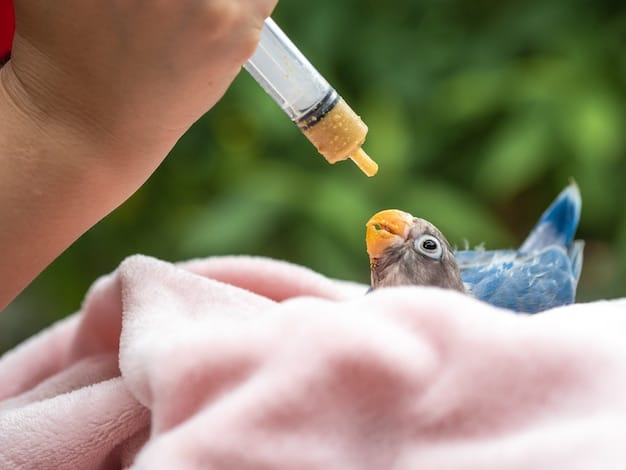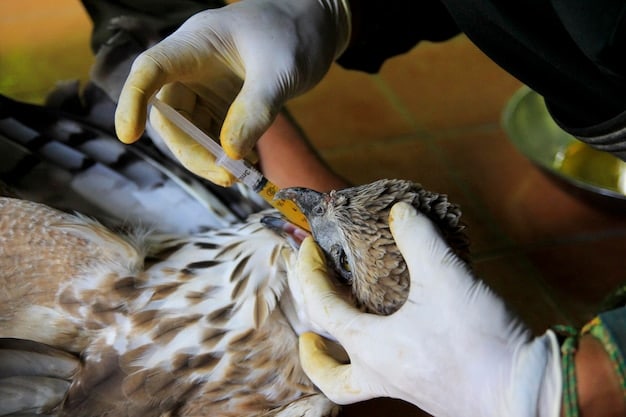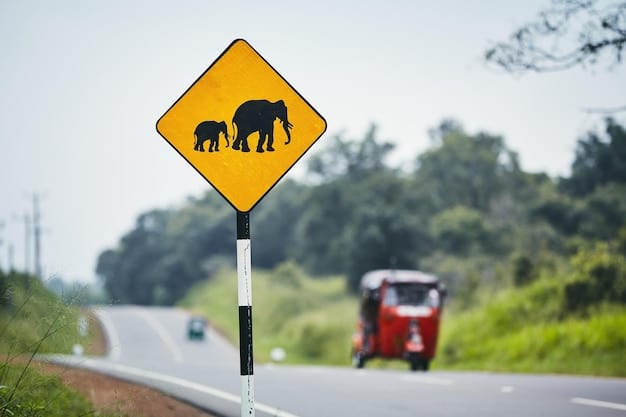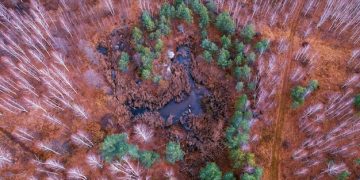Wildlife Rehabilitation: How to Help Injured Animals in the US

Wildlife rehabilitation involves rescuing and caring for injured, orphaned, or displaced wild animals with the goal of releasing them back into their natural habitat; supporting US rehabilitation centers ensures these animals receive necessary medical care, nutrition, and safe environments to recover and thrive.
Discover the truth about wildlife rehabilitation in the US. Learn what happens to injured animals and how you can support local centers dedicated to their recovery and release.
Understanding Wildlife Rehabilitation
Wildlife rehabilitation is a critical field dedicated to rescuing, treating, and rehabilitating injured, orphaned, or displaced wild animals. The ultimate goal is to release these animals back into their natural habitat, contributing to the conservation of local wildlife populations.
Rehabilitation centers play a vital role in this process, providing specialized care that many animals would not otherwise receive.

The Core Principles of Wildlife Rehabilitation
Wildlife rehabilitation operates on a foundation of several core principles, each designed to ensure the best possible outcomes for the animals in care.
- Minimizing Stress: Rehabilitation centers strive to create environments that minimize stress for wild animals, recognizing that stress can impede recovery.
- Providing Appropriate Care: Animals receive species-specific diets, housing, and medical treatment tailored to their individual needs.
- Maintaining Wildness: Rehabilitators avoid habituating animals to human presence, ensuring they retain the skills and behaviors necessary for survival in the wild.
These principles guide every aspect of rehabilitation, from intake to release, prioritizing the well-being and long-term survival of the animals.
In conclusion, understanding the principles of wildlife rehabilitation shows its commitment to helping injured animals return to their natural habitats.
The Rehabilitation Process: From Rescue to Release
The journey of an animal through a wildlife rehabilitation center is multifaceted, involving several key stages designed to maximize its chances of recovery and successful reintroduction to the wild.
Each stage requires specialized knowledge and resources to ensure the animal’s well-being.
Initial Assessment and Stabilization
When an animal arrives at a rehabilitation center, the first step is a thorough assessment of its condition. This includes a physical examination to identify injuries, dehydration, and underlying health issues.
Emergency care is provided to stabilize the animal, addressing immediate threats to its life.
Treatment and Recovery
Following stabilization, animals receive medical treatment tailored to their specific needs. This may include wound care, surgery, medication, and supportive therapies.
During recovery, animals are housed in appropriate enclosures that provide a safe and comfortable environment.
Pre-Release Conditioning
Before release, animals undergo a period of pre-release conditioning to ensure they are physically and behaviorally prepared for life in the wild. This may involve flight training for birds, foraging exercises for mammals, and socialization with conspecifics.
The goal is to restore the animal’s natural abilities and instincts.
In conclusion, the rehabilitation process is a comprehensive journey, designed to maximize an animal’s chances of successful return to its natural habitat.
Common Injuries and Ailments in Wildlife
Wildlife rehabilitation centers encounter a wide variety of injuries and ailments in the animals they treat. Understanding these common issues provides insight into the challenges faced by wildlife and the importance of rehabilitation efforts.
These injuries often result from human activities or natural events.

Trauma from Vehicle Collisions
Vehicle collisions are a leading cause of injury for many wildlife species, particularly mammals and birds. These collisions can result in fractures, head trauma, and internal injuries, often requiring extensive medical care.
Rehabilitation centers play a critical role in treating and rehabilitating animals injured in this way.
Entanglement in Human Debris
Animals can become entangled in various forms of human debris, such as plastic bags, fishing line, and discarded netting. Entanglement can cause severe injuries, including constrictions, lacerations, and even death.
Rehabilitators carefully remove these materials and treat any resulting wounds.
Exposure to Toxins
Wildlife is often exposed to toxins in the environment, including pesticides, herbicides, and lead. Exposure to these substances can cause a range of health problems, from neurological damage to organ failure.
Rehabilitation centers work to detoxify and support animals affected by toxins.
In conclusion, addressing these common injuries and ailments requires dedicated resources and expertise, highlighting the importance of supporting wildlife rehabilitation centers.
Ethical Considerations in Wildlife Rehabilitation
Wildlife rehabilitation is guided by a strong ethical framework that prioritizes the well-being of animals and the conservation of wildlife populations. These considerations shape the decisions and practices of rehabilitators.
Adhering to ethical principles ensures that rehabilitation efforts are effective and responsible.
Prioritizing the Animal’s Welfare
The primary ethical consideration is always the welfare of the individual animal. Rehabilitators strive to minimize suffering, provide appropriate care, and make decisions that are in the animal’s best interest.
Euthanasia is considered when an animal’s injuries are too severe for recovery.
Maintaining Genetic Integrity
Rehabilitation efforts should aim to maintain the genetic integrity of local wildlife populations. This means avoiding the introduction of non-native species or the hybridization of different subspecies.
Releases should be carefully planned to support the genetic diversity of wild populations.
Respecting Natural Behaviors
Rehabilitators must respect the natural behaviors of wild animals and avoid habituating them to human presence. This is essential for ensuring their long-term survival in the wild.
Handling should be kept to a minimum, and animals should be housed in environments that mimic their natural habitats.
In conclusion, ethical considerations are central to wildlife rehabilitation, guiding every aspect of the process and ensuring that the well-being of animals and the conservation of wildlife are prioritized.
How You Can Support Wildlife Rehabilitation Centers
Supporting wildlife rehabilitation centers is essential for ensuring the continued rescue and care of injured, orphaned, and displaced wild animals. There are many ways individuals can contribute to these vital efforts.
Your support can make a significant difference in the lives of wildlife.
Donations and Fundraising
Financial donations are critical for rehabilitation centers, helping to cover the costs of medical supplies, food, housing, and staffing. Many centers rely on fundraising events and campaigns to support their work.
Donations, big or small, help rehabilitation centers offer quality care to animals in need.
Volunteering Your Time and Skills
Volunteers play a crucial role in wildlife rehabilitation, assisting with animal care, cleaning enclosures, and providing administrative support. Many centers offer training programs for volunteers, equipping them with the necessary skills.
Volunteering offers a hands-on opportunity to contribute to wildlife conservation.
Promoting Awareness and Education
Raising awareness about wildlife rehabilitation and the challenges faced by wild animals can help to inspire others to take action. Educational outreach programs can teach people about responsible wildlife interactions and how to prevent injuries.
By educating yourself and others, you can help protect local wildlife populations.
In conclusion, supporting wildlife rehabilitation centers through donations, volunteering, and advocacy ensures that these critical resources remain available for animals in need.
The Future of Wildlife Rehabilitation in the US
The field of wildlife rehabilitation is constantly evolving, with new challenges and opportunities emerging. Looking ahead, there are several key areas that will shape the future of wildlife rehabilitation in the US.
Adapting to these trends will be essential for ensuring the continued success of rehabilitation efforts.
Addressing Climate Change Impacts
Climate change is already having a significant impact on wildlife populations, altering habitats, increasing the frequency of extreme weather events, and spreading diseases. Rehabilitation centers will need to adapt their practices to address these challenges.
This may involve developing specialized care protocols for animals affected by climate change.
Integrating Technology and Research
Advances in technology and research are providing new tools for wildlife rehabilitation. Telemetry, remote monitoring, and genetic testing can help rehabilitators track animal movements, assess health, and make informed release decisions.
Embracing these innovations can improve the effectiveness of rehabilitation efforts.
Strengthening Collaboration and Partnerships
Collaboration and partnerships between rehabilitation centers, government agencies, research institutions, and conservation organizations are essential for addressing complex wildlife issues. By working together, these groups can share knowledge, resources, and expertise.
This will lead to more effective conservation outcomes.
In conclusion, the future of wildlife rehabilitation depends on adapting to new challenges, embracing innovation, and strengthening collaboration to protect wildlife populations in the US.
| Key Point | Brief Description |
|---|---|
| 🐾 Rehabilitation Meaning | Helping injured/orphaned animals go back to the wild. |
| 🚑 Care Process | Includes assessment, treatment, recovery, and pre-release. |
| ⚠️ Common Dangers | Traffic, trash, and poisons threaten wildlife welfare. |
| 🤝 Support Options | Donate money or time, raise awareness for animals! |
Frequently Asked Questions
▼
Wildlife rehabilitation is caring for sick, hurt, or young wild animals so they can return to their natural homes. It involves medical care, housing, and prepping them for life in the wild.
▼
Wild animals often land in rehab centers due to car accidents, getting tangled in trash, losing their parents, or being hurt by humans. These factors reduce their survival chances.
▼
Rehabbing wildlife is ethical when it helps animals return to the wild without depending on humans. It aims to preserve natural behaviors and genetic diversity, aiding local populations.
▼
If you spot an injured animal, keep your distance and contact your local wildlife rehab center. They’ll give you advice and may take the animal, ensuring it gets expert care.
▼
Climate change affects habitats and increases extreme events, pushing rehab centers to change how they care for animals. They must adapt to new injuries and environmental stressors to protect wildlife.
Conclusion
The truth about wildlife rehabilitation reveals a world of dedicated individuals working tirelessly to rescue and rehabilitate injured animals, offering them a second chance at life in the wild. By understanding the challenges these animals face and supporting local rehabilitation centers, you can play a vital role in protecting our native wildlife and ensuring a healthy ecosystem for future generations.





